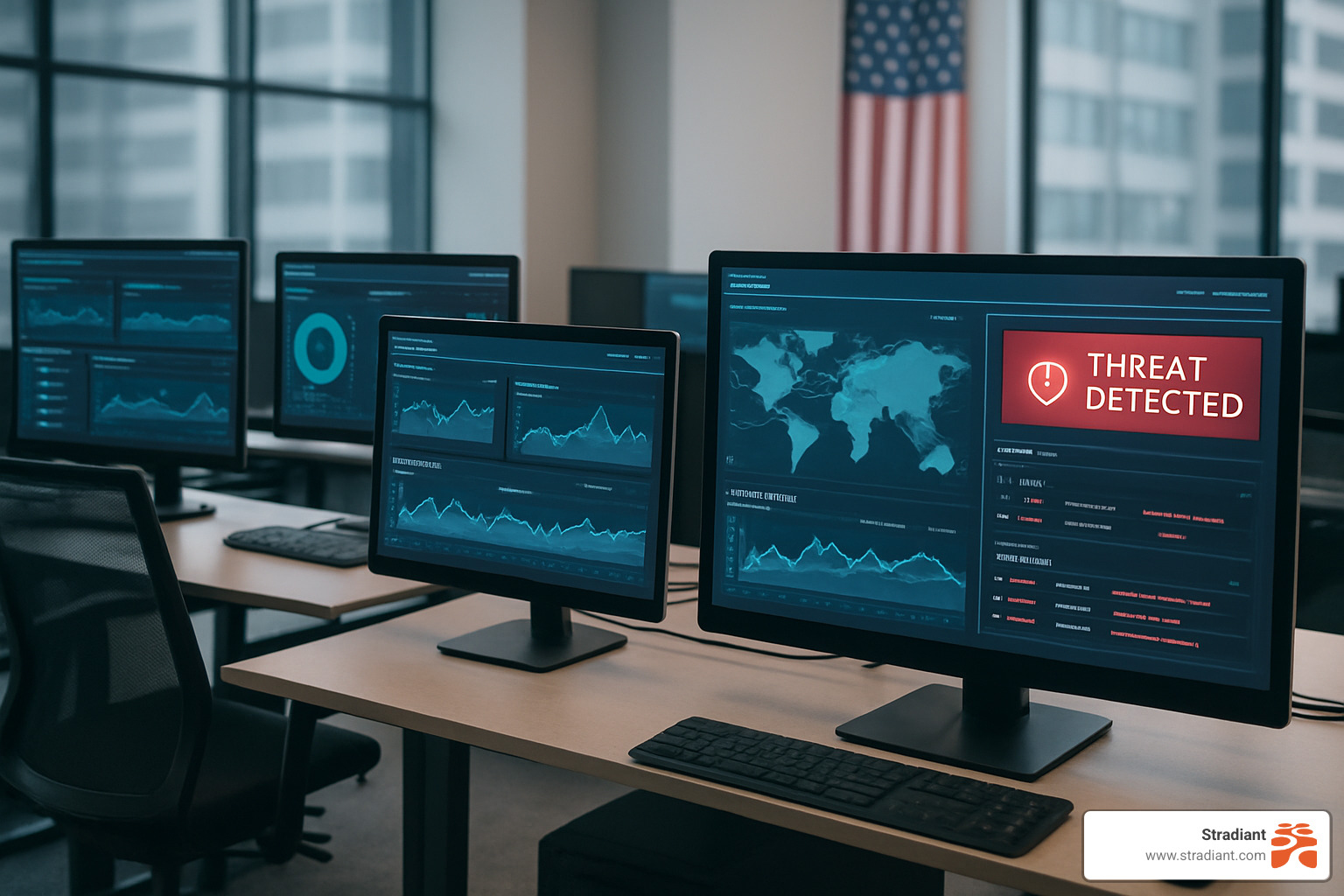The Health Insurance Portability and Accountability Act (HIPAA) sets the foundation for protecting sensitive patient information. Understanding HIPAA’s significance in healthcare is paramount for organizations handling Protected Health Information, especially when addressing IT compliance in Austin.
Training is essential for compliance with HIPAA regulations, particularly the stringent requirements that come with Austin HIPAA standards. Regular training equips staff with the necessary knowledge to safeguard patient data effectively and maintain robust cybersecurity.
Below, we’ll explore the following:
- Understanding HIPAA and its core components.
- Key HIPAA training requirements.
- Best practices for implementing effective training.
- Consequences of insufficient training.
- Steps to ensure ongoing compliance.
By focusing on these areas, businesses can create a strong compliance culture while reducing risks associated with privacy breaches.
Understanding HIPAA and Its Core Components
HIPAA is a federal law designed to protect sensitive patient information. Its primary purpose is to ensure that individuals’ health information remains confidential while allowing for the efficient exchange of this data among healthcare providers.
Protected Health Information
Protected Health Information (PHI) refers to any individually identifiable health information. This includes:
- Medical records
- Payment history
- Health status
PHI is critical in maintaining patient privacy. The unauthorized disclosure of PHI can lead to significant legal and financial consequences for healthcare organizations.
Role of the Office for Civil Rights
The Office for Civil Rights (OCR), part of the Department of Health and Human Services, is responsible for enforcing compliance with HIPAA regulations. Key responsibilities include:
- Investigating complaints related to HIPAA violations
- Conducting compliance reviews
- Imposing penalties for non-compliance
Understanding these core components is essential for healthcare organizations to implement robust training programs and maintain compliance with HIPAA standards.
Key HIPAA Training Requirements
Compliance with HIPAA regulations necessitates mandatory HIPAA training for all personnel involved in handling PHI. This requirement encompasses various roles within healthcare settings. The following key personnel must undergo training:
- Doctors
- Nurses
- Administrators
- Front Desk Personnel
- Residents on Rotation
Annual training sessions are crucial to ensure that all staff remain abreast of the latest policies, procedures, and security practices. The healthcare environment is dynamic; continuous education helps mitigate risks associated with non-compliance.
Recommended Training Frequency
The frequency of HIPAA training largely depends on specific roles and organizational changes. Recommendations include:
- Annual Training: All employees should participate in refresher courses at least once a year.
- New Hires: Training should be conducted within a “reasonable period” after onboarding to ensure immediate compliance.
- Policy Changes: Any updates to existing policies or introduction of new procedures necessitate additional training sessions.
These measures help maintain a culture of compliance and reinforce the importance of safeguarding PHI.
Critical Topics for HIPAA Training
Effective training programs must cover essential topics that align with the requirements set forth by HIPAA. These include:
- Privacy Policies: Understanding patient rights and organizational responsibilities regarding PHI.
- Security Protocols: Emphasis on safeguarding electronic Protected Health Information (e-PHI) from unauthorized access.
- Inadvertent Sharing Prevention: Strategies to prevent accidental disclosures through both physical and electronic means.
- Role-Specific Content: Tailoring training materials to address the unique responsibilities of different job functions.
Utilizing real-life scenarios during training can enhance comprehension and retention among staff members. For example, role-specific case studies enable employees to connect theoretical knowledge with practical application, thus fostering an environment where privacy and security are prioritized.
Incorporating these elements into employee training for HIPAA is not merely a regulatory checkbox; it serves as a proactive measure to protect sensitive patient information and uphold the integrity of healthcare organizations. Adherence to these guidelines not only supports compliance but also strengthens trust between patients and providers, reinforcing the ethical obligation to protect patient confidentiality.
Documentation and Tracking Training Completion
Engaging in effective HIPAA training extends beyond just delivering content; it incorporates a robust system for documentation and tracking. Proper records are essential to demonstrate compliance and readiness during audits or investigations.
Key elements of documentation include:
- Name of Training: Clearly define the title of each training session to avoid confusion.
- Description: Provide a brief overview of what the training covered, focusing on its relevance to HIPAA requirements.
- Completion Date: Record when each employee completed the training. This assists in tracking when refresher courses are necessary.
Maintaining accurate records serves multiple purposes:
- Compliance Proof: In the case of an Office for Civil Rights (OCR) investigation, documented training acts as evidence of compliance with HIPAA regulations.
- Identifying Gaps: Regularly reviewing training records can highlight which employees may need additional instruction or updates based on changing policies.
- Training Efficacy: Documentation helps assess the effectiveness of various training methods, enabling organizations to pivot strategies if necessary.
Incorporating engaging HIPAA training methods enhances retention and understanding among staff. Utilizing gamification techniques—such as interactive quizzes, crossword puzzles, or even treasure hunts—can make learning enjoyable while still informative.
Regularly scheduled documentation reviews help maintain a culture of compliance within your organization. Keeping track of which personnel have received specific types of training enables healthcare providers to ensure that everyone is adequately prepared to handle Protected Health Information (PHI) securely.
Implementing these best practices creates a strong foundation for not just meeting but exceeding HIPAA training requirements. By prioritizing both engaging content and meticulous documentation, businesses can bolster their defenses against potential breaches while fostering an environment of ongoing learning and improvement.
Consequences of Insufficient HIPAA Training
Insufficient training on HIPAA can lead to severe consequences for healthcare organizations. Legal repercussions are significant, including:
- Civil Monetary Penalties: Non-compliance can result in fines that vary based on the severity and duration of the violation.
- Office for Civil Rights (OCR) Investigations: Organizations may face scrutiny and audits from OCR, leading to further complications.
The impact extends beyond legal penalties. Patient privacy becomes compromised, which not only affects individuals but also damages the organization’s reputation.
Engaging HIPAA training methods are essential to avert these risks. Utilizing innovative techniques like gamification and interactive quizzes can enhance learning and retention among staff. Look for a HIPAA training platform that offers a robust solution with features such as:
- Short videos tailored to different roles
- Automated security reminders
- Policy assignment functionalities
Training documentation is critical during audits or investigations, ensuring that all personnel have completed the required training. Without proper documentation, organizations risk facing even harsher penalties for non-compliance. Investing in effective training methods safeguards both patient information and organizational integrity, fostering a culture of compliance that is essential in the healthcare sector.
Steps to Ensure Compliance with HIPAA Standards
Compliance with HIPAA standards is an ongoing process that requires continuous attention and action. Regular risk assessments are essential in identifying vulnerabilities within your organization. By systematically evaluating your practices, you can uncover potential areas of non-compliance and ensure that Protected Health Information (PHI) remains secure.
Importance of Regular Risk Assessments
Conducting regular risk assessments provides several key benefits:
- Identify Vulnerabilities: Discover weaknesses in current security measures, policies, and procedures.
- Evaluate Impact: Understand the consequences of potential breaches on patient privacy and trust.
- Prioritize Resources: Allocate time and resources effectively to address the most pressing compliance issues.
Creating a Culture of Privacy
Creating a culture of privacy should be an organizational priority. In regions with a strong focus on compliance, such as Austin cybersecurity initiatives, promoting awareness among staff regarding the significance of safeguarding PHI becomes even more critical. Proactive measures to foster this culture include:
- Regular Training Sessions: Ensure ongoing education about HIPAA requirements and best practices.
- Open Communication Channels: Encourage staff to report concerns or incidents without fear of reprisal.
- Recognition Programs: Acknowledge employees who demonstrate exemplary adherence to HIPAA standards.
Developing a Corrective Action Plan
When deficiencies are identified during audits or assessments, implementing a Corrective Action Plan (CAP) is crucial. This structured approach not only addresses immediate issues but also lays the groundwork for continuous improvement in compliance practices. Effective CAPs should include:
- Identification of Issues: Clearly define the specific areas where compliance was lacking.
- Root Cause Analysis: Investigate underlying reasons for non-compliance to prevent recurrence.
- Action Steps: Outline specific actions needed to rectify deficiencies.
- Timeline for Implementation: Establish realistic deadlines for completing corrective actions.
- Responsible Parties: Assign accountability to individuals or teams for each action item.
Continuous improvement in compliance practices hinges on regular evaluations and updates. Monitoring outcomes from implemented CAPs allows organizations to assess their effectiveness and make necessary adjustments over time. Keeping documentation of these processes is vital as it serves as evidence during audits.
Incorporating these steps into your organization’s compliance strategy not only enhances adherence to HIPAA standards but also promotes a culture committed to protecting patient information at every level. Emphasizing the importance of regular risk assessments and corrective actions strengthens your organization’s position against legal repercussions while prioritizing patient trust and confidentiality.
Ensuring Ongoing Compliance with Proactive Training
Prioritizing patient privacy and data security is essential for any organization handling Protected Health Information (PHI), especially with rising concerns regarding Austin cybersecurity. Implementing best practices for HIPAA compliance ensures that staff are equipped to manage sensitive data responsibly.
Key strategies include:
- Regular Training: Continuous education on HIPAA standards keeps employees informed about their responsibilities.
- Engagement Tools: Utilize gamification and interactive content to make training more engaging and effective.
- Role-Specific Content: Tailor training sessions to address the unique needs of different roles within your organization.
Consider leveraging specialized software to streamline compliance efforts. This platform offers automated training reminders, role-specific learning modules, and performance tracking, ensuring your team remains compliant with evolving regulations for HIPAA.
Invest in tools and resources that reinforce a culture of privacy, safeguarding your organization against potential breaches and legal repercussions associated with IT compliance.
Frequently Asked Questions About HIPAA Training
What is HIPAA and why is it important in healthcare?
The Health Insurance Portability and Accountability Act (HIPAA) is a federal law designed to protect patient privacy and secure personal health information (PHI). Its importance in healthcare lies in ensuring that sensitive patient data is handled with care, promoting trust between patients and healthcare providers.
Who needs to undergo HIPAA training?
HIPAA training is mandatory for all personnel who handle PHI, including doctors, nurses, administrators, and any staff involved in patient care or health information management. It is crucial for maintaining compliance with HIPAA standards.
How often is HIPAA training required?
HIPAA training should be conducted annually for all employees. Training is required whenever there are new hires or significant policy changes that impact how PHI is managed.
What are some best practices for implementing effective HIPAA training?
Best practices for implementing HIPAA training include using engaging methods such as gamification and interactive quizzes. Utilizing platforms like HIPAAtrek can enhance the learning experience, ensuring that training content is relevant and tailored to specific roles within the organization.
What are the consequences of insufficient HIPAA training?
Insufficient HIPAA training can lead to serious legal repercussions, including civil monetary penalties and investigations by the Office for Civil Rights (OCR). It can negatively impact patient privacy and damage an organization’s reputation.
How can organizations ensure ongoing compliance with HIPAA standards?
Organizations can ensure ongoing compliance with HIPAA standards by conducting regular risk assessments to identify vulnerabilities, developing corrective action plans when deficiencies are found, and fostering a culture of privacy through proactive measures. Seeking professional assistance or utilizing specialized software like HIPAAtrek can also streamline compliance efforts.








